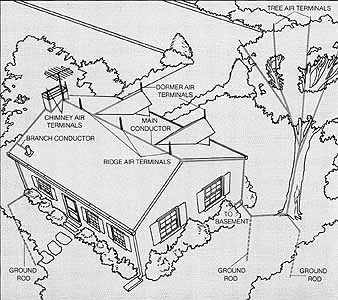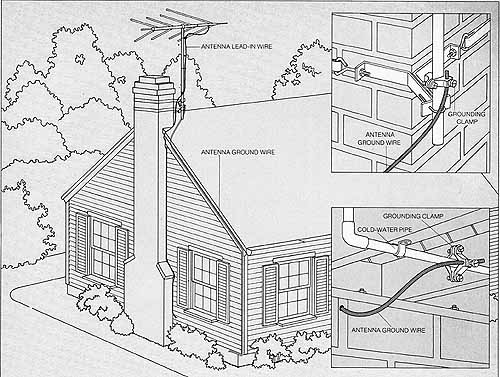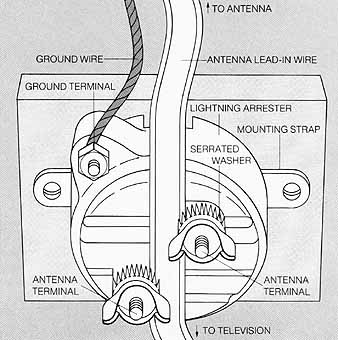Safeguarding a home from the million or more volts of a lightning flash calls for a professional contractor, not just because only he has the expertise and special equipment necessary to install and test the system, but, more important, because an improperly installed system is likely to pose a greater hazard to your home than no protection at all. But there are some things you can do yourself.
Make sure that wiring and appliances are protected from lightning-surge dam age—the powerful currents that can run into the house through overhead power lines or antenna cables when lightning strikes in the area. Such currents are diverted to the ground by lightning arresters or surge protectors, installed at the main fuse or circuit-breaker panel and on the television antenna lead-in. Installing an arrester on the power lines is a job for an expert—it requires working on hot wires from the utility lines in the street —but attaching an arrester to the antenna lead-in wire is a simple screwdriver job (opposite bottom). The arrester shown is designed for use with a 300-ohm flat lead-in; arresters for 75-ohm coaxial cable are also available. In either case, the arrester should carry the Underwriters’ Laboratories (UL) seal.
The antenna mast itself should also be grounded; if it's not, connect it to a grounded water pipe (opposite top). Clamps and wire for mast grounding, as well as lead-in arresters, are available at electrical and electronic-supply stores.
Remember that these measures don't provide adequate lightning protection in the event of a direct strike to your home or antenna; only a professionally de signed system with heavy-gauge conductors and alternate paths to ground can afford that safety. But these measures may prevent a burn-out of ex pensive electrical equipment.
Although surge arresters and antenna grounds are advisable everywhere, not every home needs a full-scale lightning protection system. One should be considered, however, if you live in an area of frequent thunderstorms such as central Florida or the thunderstorm belts of the Southeast or Midwest; in New Eng land, thunderstorms occur less frequently but are often very severe. If your home is the tallest and largest in the neighbor hood (a tall metal antenna effectively raises the roof height) or if it's isolated, it's more likely to be hit since it will be the dominant structure in the area.
If you do decide to have a complete protection system, insist that the installation conform to the standards of the National Fire Protection Association and the Underwriters’ Laboratories. When the job is completed, UL-certified installers will submit an application, witnessed by the homeowner, for a UL Master Label. This label, actually a brass plate affixed to the equipment, certifies that the system has been professionally installed and subjects it to spot-checking by UL field inspectors. The Master Label may entitle you to a rate reduction on your home owner’s insurance policy.
After the system is installed, inspect it annually. Check for bent, loose or missing air terminals, as well as breaks or fraying in the conductors; make certain clamps and splices are tight, and that no new construction near the house has damaged the buried rods and cable.

A lightning protection system.
In a professional installation, thin, pointed rods called air terminals are
placed along the high points of the roof-ridge, dormers and chimney—where
they will intercept a direct lightning strike. A main conductor of heavy-gauge
copper or aluminum cable joins the terminals to one another and to at least
two copper ground rods driven into the earth at diagonally opposite corners
of the house.
Prominent metal objects on the roof, such as the television antenna, are connected to the main conductor; other large metal objects within 6 feet of the main cable, such as the plumbing system’s vent pipe, gutters and downspouts, and metal flashings, are connected with smaller- gauge branch conductors. Another branch conductor enters the basement to tie in the plumbing, electrical and telephone systems.
Any tree taller than the house and located within 10 feet of the foundation should be protected with special tree terminals—not only to protect the tree, but to guard the house against side flashes that might leap from the tree if it's struck.
Protection for Electronics including Computers, Hi-Fi and TV Sets

Grounding the antenna. Attach a length
of No. 8 aluminum or No. 10 copper wire to the mast with a grounding clamp
(inset, top), making sure that the ground wire is securely held in the clamp.
Run the wire along the eave and down the siding, securing it every 3 to 4
feet with staples. Use another grounding clamp to attach the other cable
end to a metal cold-water pipe in the basement.

Installing the lightning arrester.
Attach the arrester to the antenna lead-in wire at the lowest possible point—where
it will be close to a good ground connection—generally near the point where
the lead-in enters the house. Lay the lead-in into the groove on the face
of the arrester and tighten the wing nuts on each terminal so that the serrated
washers penetrate the insulation and make contact with the wires. Mount the
arrester, using the mounting strap and wood screws provided. Attach a wire
to the ground terminal and clamp it to a grounded water pipe.
Next: Coping with the Chaos of a Flood